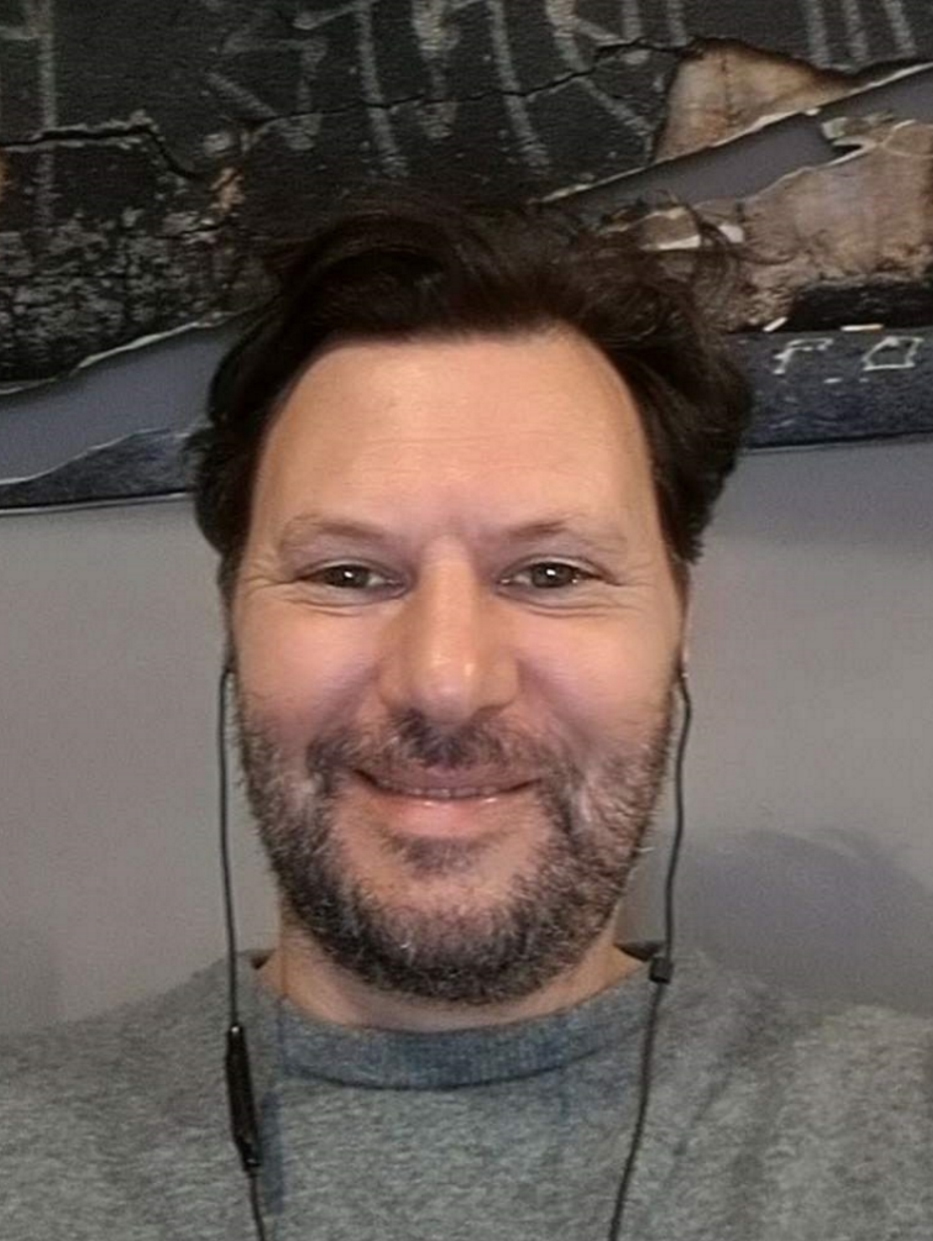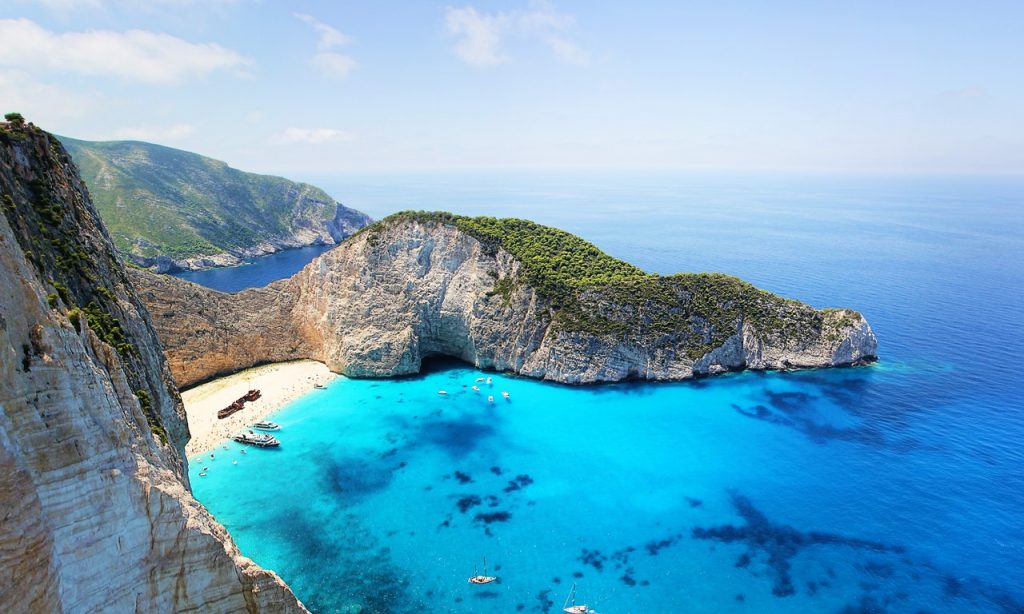
Whenever you walk into a church, you will find tons of symbolism, most of which goes unexplained to churchgoers. The general public is only typically given the exoteric explanation. The problem with exoteric symbolism is that you are only given a glimpse of its true meaning – and that can be more dangerous than it is beneficial.
Being a Greek island, I assumed the Church of Dionysios in Zakynthos was named after the paradoxical God, Dionysus, the God of wine and merriment. Dionysus is the embodiment of balance and the ability to raise conscious awareness – and still have fun. The church in Zakynthos, however, is said to be dedicated to a pious fella the Church fathers of the 16th Century renamed, Dennis.
The pious Dionysios is classed as a saint because he gave up his worldly possessions in order to dedicate his life to the church. Given the name, Draganinos at birth, he was the son of a royal Venetian family but refused his advantageous social position to encourage Greek islanders to serve Jesus.
Draganinos was a deep thinker and recognised for his wisdom and beneficence. During a mission to the Holy Land, he was invited to assume a post as Archbishop on the island of Aegina where he was given the name Dionysios.
Built in 1708, the church stands looking out across the port. The large bell tower cuts an imposing figure on the skyline and Byzantine architecture dwarves the surrounding buildings. The facade features the typical three arches and twin pillars representing Jachin and Boaz.
Jachin and Boaz are the name’s given to the two pillars that appear prominently on the Freemason’s tracing board. Furthermore, they are the names given to the twin pillars or towers built into Christian churches and Gothic Cathedrals.
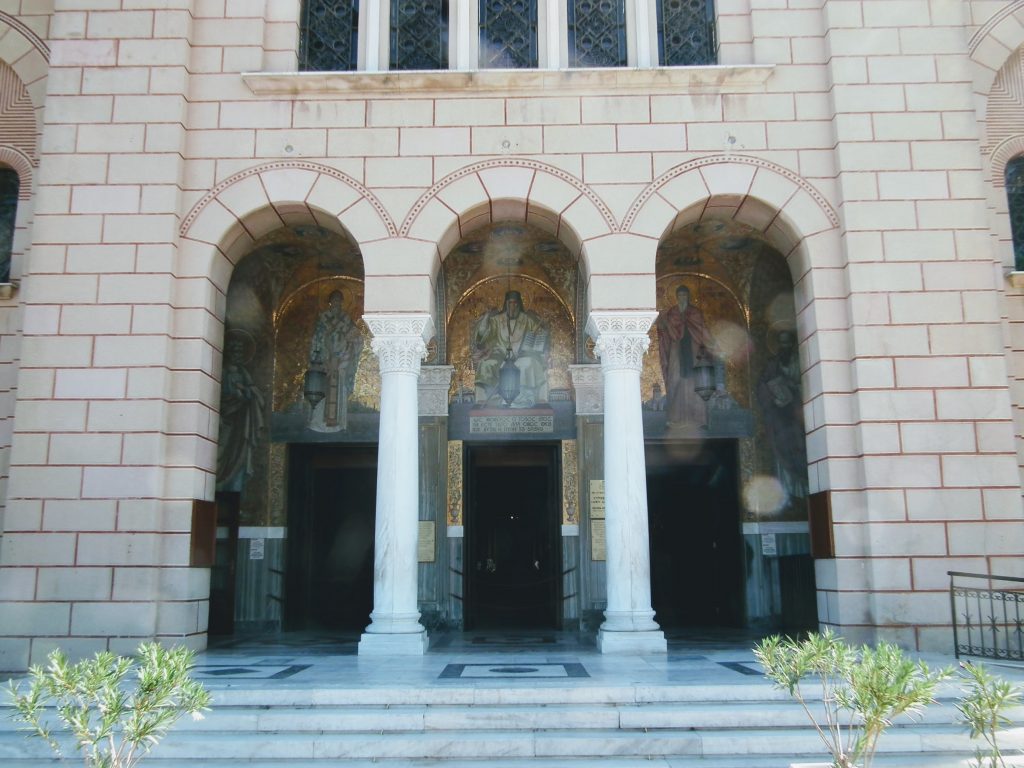
In Christian and Masonic legends, it is written as historical that Jachin and Boaz were the chief builders of King Solomon’s Temple designed by the architect, Hiram Abiff. However, Solomon’s Temple, like modern churches, is allegorical. The esoteric symbolism represents the human body and the traits we need to develop during the course of your lifetime.
You are probably familiar with the popular saying, ‘my body is a temple.’ Well, throughout the world, the temples and churches dedicated to various gods and saints reflect the body. A temple is your body. The twin pillars of Jachin and Boaz at the entrance to the church are the legs.
The deeper meaning of Boaz, given in Hebrew, is “In him is strength” or rather the wise man has strength. Wisdom is earned when you act out the knowledge you have. From the ego perspective, acting upon information is sometimes difficult because it means stepping outside of your comfort zone and performing a new task you are unfamiliar with. In such circumstances, we are so often troubled by fear, even though there is nothing to fear other than fear itself.
Jachin, the pillar which stands on the south side of the entrance means ‘He will establish’. Jachin stands on the south which in cosmology is symbolic of the sun’s rise to its highest point. Esoteric symbolism for the sun represents illumination – to be enlightened.
Christian accounts claim Boaz was a descendant of the House of David and thus Solomon, the ruler whose temple he is building. Yet in the book of Ruth, Boaz is described as the great grandfather of King David, thus the great-great-grandfather of King Solomon.
Although people are said to have lived to a ripe old age in the Bible, the historical testimony seems to be a little at odds here albeit confused by the legends presented to Freemasons. However, allegorically it makes perfect sense. Boaz is an early member of the bloodline that ultimately ends with Jesus who is the biblical symbol of an enlightened man.
Boaz, on the other hand, stands on the north side of the church. In esoteric symbolism, the direction of north symbolises being in the dark as the sun never shines to the north. This is the cosmological allegory of being ‘in the dark’ ignorant, disillusioned and consciously sleeping.

“In symbolism, the body is divided vertically into halves, the right half being considered as light and the left half as darkness. By those unacquainted with the true meanings of light and darkness the light half was denominated spiritual and the left material.” ~ Manly P. Hall
Ancient mystery schools taught initiates to bring the lower nature towards an elevated state of human consciousness. It was taught that through acts of righteousness and rational thinking, consciousness would regenerate and culminate in a higher spiritual understanding within man. The challenge is to overcome the delusion of the material world and discover your true nature.
In Revelation 3:12, the promises made to Boaz and Jachin read:
“The one who is victorious (overcomes physical reality), I will make a pillar in the temple of my God. Never again will he leave it. I will write on him the name of my God and the name of the city of my God, the new Jerusalem, which is coming down out of heaven from my God; and I will also write on him my new name.”
Another interesting symbol located at the entrance of St. Dionysios Church is a double-headed eagle. This is a symbol that is largely associated with imperial empires but has a deeper meaning connected with the regeneration of bioenergy.

History records that the Hittites used the double-headed eagle as far back as 1800BCE, although these images sculptured into Sumerian tablets indicate the motif is much older. The symbol of the double-headed eagle was also used by the Byzantine and Roman Empires before being passed down to the Holy Roman Empire until its dissolution in 1806.
The Catholic Church is clearly still using the emblem together with a crown which replaces the earlier use of haloes. The crown, obviously associated with royalty, denotes the highest faculty of mind when endowed with the highest degrees of consciousness.
The symbol of the eagle features in multiple ancient cultures. The pinnacle of all birds typically represents strength, courage, farsightedness and was considered to be the messenger of the gods. But this explanation is the exoteric version which only presents us with a glimmer of the truth.
As the eagle is considered the king of the skies, ancient scribes assigned it to the respective king of the Gods; Zeus, Jupiter, Odin, Vishnu and his consort Lakshmi. The ‘feathered serpent’ gods of Mesoamerica, Quetzalcoatl and Kul’ul’kan, also have associations with eagles and Mexico’s flag featuring an eagle with a serpent in its mouth is also symptomatic of the esoteric meaning behind the double-headed eagle.
Manley P. Hall, 33rd degree Mason and commentator of esoteric symbolism, reveals the double-headed eagle replicates the ancient image of a double-headed phoenix, well known for rising from the ashes under the Latin banner ‘Ordo Ab Chao’ meaning “Order out of chaos”.
Here we have our first clue to the deeper, esoteric meaning of the double-headed eagle. In the Masonic tradition, the double-headed eagle of Kadosh is the 30-32nd degree of masonry. In some representations, one of the eagles is depicted in white the other in black reflecting duality.
It has been proposed that the two eagles represent the male and female aspects of mankind. But this is only another part of the symbols deeper meaning. But in actual fact, the eagle represents the two aspects of the subconscious which ranges along a spectrum of personality traits from good to evil, purity to decay.
The black symbolises decay and the white sublimation. This is the process of regenerating the negative aspects of character and lower states of conscious awareness in hermetic alchemy, which incidentally shares the same principles of ancient wisdom and modern masonry.
Gilberthouse.org reveal the double-headed eagle of the Scottish Rite Freemasons represents the highest degrees and is associated with the Sumerian God of War and hunter, Ninurta and Nimrod, described in Genesis 10:9 as a ‘mighty hunter’.
Ninurta was depicted as a farmer and associated with rainstorms and thunder. A farmer is symbolic of cultivation whilst rainstorms and thunder is symbolic principles for growth and consciousness, or in other words expanding consciousness out of ego into a higher state of mind.
The same idea is expressed in the story of Nimrod in the Bible who is also associated with the double-headed eagle. In ancient Hebrew, Nimrod means ‘we will revolt’ earning him the reputation as a rebel in opposition to YHWH, the Hebrew God. Biblical accounts also reveal that Nimrod established several kingdoms, symbolic of our personality traits – the characters within us that rule.
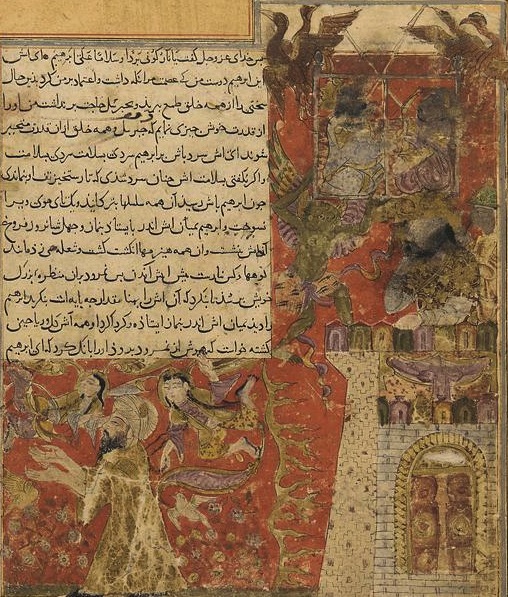
According to Dr. Joseph Murphy in his book, ‘The Power of the Subconscious Mind’ our subconscious is predominantly the cause of our reality and personality.
Psychologists today believe that the subconscious mind makes our decisions around 90-95%% of the time.
There is very little information about Nimrod, but the early historian Josephus confirms the King excited his people ‘to such an affront and contempt of God…He persuaded them not to ascribe to God’ and convinced his subjects they would be happy through his means only.
Josephus also explains Nimrod, ‘gradually changed the government (ruling personalities) into tyranny seeing no other way of turning men from the fear of God, but to bring them into constant dependence upon his power.’
It is clear that Nimrod represents ignorance and the ego’s attachment to the material world which ultimately results in character flaws, bad attitudes and narrow-minded views. This is the decay from which the black phoenix has to rise from in order to transform into the pure mind of higher consciousness. The white coloured eagle/phoenix is symbolic of illumination.
Thus the double-headed eagle represents the dual nature of human consciousness and our struggle to transform energy from bad luck to good luck. It explains the challenge we are faced with to wake up from the darkness by walking in the light, or in other words, growing out of our ignorant, narrow-minded state and developing a broader awareness of our immediate world and being grateful for this experience. The more you expand conscious awareness the more you enjoy life and the more you appreciate what you have.
As the eagle is the messenger of the gods, there is also the suggestion this symbol represents the thoughts that surface in the conscious mind from the subconscious. The Indians of the Americas also related the eagle as the bird closest to God and represents courage. It takes courage to break away from old habits and attitudes, but we have no choice if we want to grow and improve our reality.
At the head of the aisle are two depictions of a square within a square, otherwise known as the seal of Melchizedek. The symbol is sometimes clearly shown as an eight-pointed star and nearly always with a circle at the centre representing the ethereal plane.
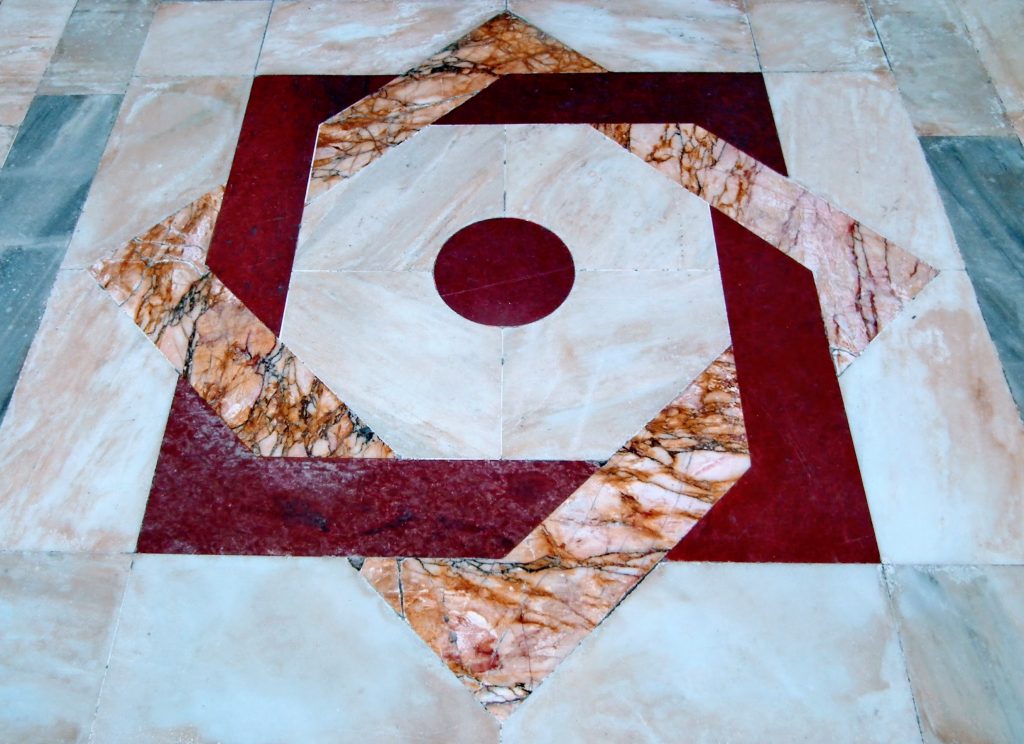
Melchizedek is a biblical king known for his righteousness. Although little is known about the King, his name is synonymous with Jesus. According to Alan Rex Mitchell in his book, The Seal of Melchizedek: Exploring the Modern Rebirth of an ancient symbol, the eight-pointed star is also referred to as the Seal of Christ.
In esoteric symbolism, stars represent the sun, more specifically, they represent our sun, the source of light and life on Earth. Thus we also find Jesus symbolising the sun surrounded by the 12 disciples each of whom represents a sign of the zodiac (i.e Judas is Scorpio, the scorpion – the betrayer/back-stabber).
One way you can look at this concept is that the seven is actually the moment of understanding once we acquire new information and behave in a different way or change our belief about something. Esoteric symbolism behind the eight reveals that acting on knowledge leads to wisdom – a reprogramming of the subconscious whereby the new responses become automatic.
For example, when you are on the path to change a habit or engaged in a project, you have to learn new ways of behaving. The esoteric symbolism given for the seven represents the stage whereby you acquire knowledge and understand what you have to do. You go through a process of change. The eight is a continuation of the transformation, and the stage in which the regeneration process starts to takes place.
The octagram is also the symbolic expression of the law of cause and effect. Buddhism reflects this is the dharma wheel or wheel of life that moves in cyclical motion. The eight-pointed star is this associated with transformation through actions and is associated with resurrection, prosperity, fate and justice.
On a practical level, the Buddhas’ Noble Eightfold Path instructs initiates to cultivate their minds through:
According to religiousfacts.com, related verses in the Bible explain “we ourselves were also once foolish, disobedient, deceived, serving various lusts and pleasures, living in malice and envy, hateful and hating one another. But when the kindness and the love of God our Savior toward man appeared, not by works of righteousness which we have done, but according to His mercy He saved us, through the washing of regeneration and renewing of the Holy Spirit…”
Forget that last bit, that’s religious crap the church wants you to think. As I will show you later, we have to be righteous in order to regenerate. The “mercy” of God is a fallacy invented by the church to mislead people. You are in control of your own destiny through the Noble Eightfold Path.
The first part of the statement (highlighted) points out traits that are typical in mankind when we are children. It is during our childhood that we develop the views of the world that ultimately define our character and attitudes towards life and others.
We act this way because we are still operating on subconscious programs developed from the time we are born until the age of seven. Thus the square represents the material world and reflects man that is living in ignorance and delusion, blind to his true nature.
From a negative viewpoint then, the square within a square can depict total ignorance that is twice the power in adults than it is in children. The eight-pointed star still represents new beginnings but we continue to operate with the old habits that are stored in our subconscious programming. Old habits generate the same energies so you continue to have the same experiences in life – only each time you fail a life lesson the judgements get harsher. This is what people call bad luck. In reality, it is bad energy.
The ancient Babylonians assigned the eight-pointed star to the goddess Ishtar whose story in mythology is retold in the Bible with the tale of Christ’s crucifixion. Ishtar would later lend her name to Easter, although the English word derives from the German goddess Eostre who is also a goddess of resurrection.
In Babylonian myth, Ishtar goes in search of her husband, Tammuz. The adventure is considered to be the Quest for Wisdom. Ishtar has to descend into the underworld and pass through seven gates before she can rescue her lover.
The story of Jacob is symbolic of making sacrifices in order to be ‘reborn’ or ‘resurrected’ and shares similarities with the crucifixion story – Christ dying at the age of 33 and sitting on the right side of God in heaven. All these myths explain that we have to sacrifice old habits in order to bring in new personality traits, attitudes, beliefs and experiences.
The same concept is found in the story of the Sumerian myth, the descent of Inanna and the Greek fable in which Orpheus goes in search of his lover, Eurydice, both of which closely resemble the story of Ishtar.
Furthermore, Ishtar is associated with the planet Venus that take eight years to orbit the sun. Venus is known as the evening and the morning star, representing the duality of mankind, good and evil, light and dark.
Again we see the same symbolism in the Bible. In Revelation 22:16, Jesus reveals:
“I am the bright morning star.” As the morning star, Venus is known as the light bringer and is a sign of the new day and new beginnings, plus the continuous cycle of nature.
In Isaiah 14:12 Lucifer, which means ‘the light-bringer’, is also referred to as the ‘the star of the morning’. Lucifer represents the fall of man that has turned his back on divine consciousness to dwell in the inferior world. Satan is said to represent sin, but sins are code for mistakes. And when you learn from your mistakes you develop new ways of being.
The number eight, together with the other symbols leading from the entrance to the aisle of the Dionysios Church are symbolic of regeneration through the vitalizing power, a concept that is also synonymous with the Greek God Dionysus.
You may recall I thought the Church of Dionysios in Zakynthos was merely a disguised Christian tribute to the Greek God of wine. So I looked for grapes, the symbol of Dionysus, and sure enough, I found them – on the donation box. Given Saint Dionysus gave up his wealth and was known as a great benefactor blessed with wisdom, he is used as a role model reminding us that we need to turn our back on our old values in order to create a future in which we acquire wisdom.
